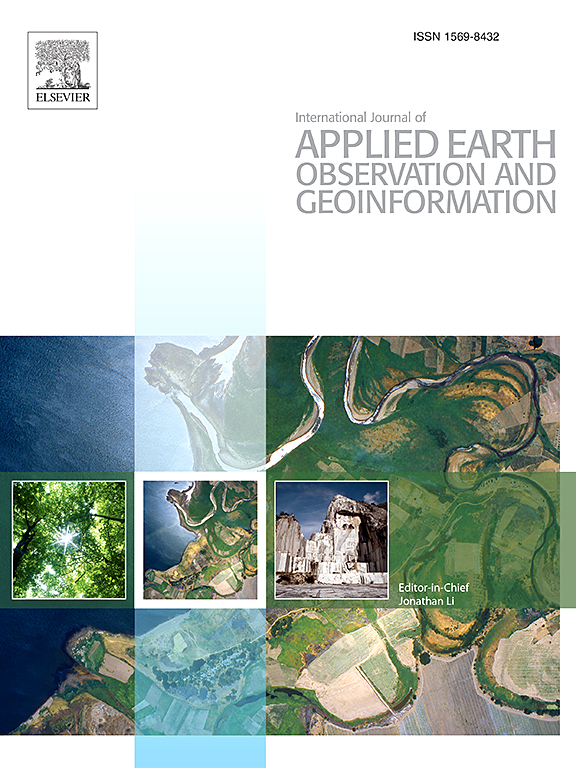Seamless global daily soil moisture mapping using deep learning based spatiotemporal fusion
IF 7.6
Q1 REMOTE SENSING
International journal of applied earth observation and geoinformation : ITC journal
Pub Date : 2025-04-08
DOI:10.1016/j.jag.2025.104517
引用次数: 0
Abstract
Soil moisture products with long-term, high spatial continuity, and high accuracy are essential for meteorological management and hydrological monitoring. Microwave remote sensing retrieval and land surface model simulation are the two primary sources of global-scale soil moisture data, but each has inherent limitations, making it difficult to balance accuracy and spatial coverage. In this paper, to tackle this challenge, we propose a deep learning-based spatiotemporal fusion framework to integrate the two data sources and generate a global soil moisture product with high spatial continuity and accuracy. Specifically, we leverage the high accuracy of the Soil Moisture Active and Passive (SMAP) microwave soil moisture data and the spatiotemporal continuity of the Noah assimilation soil moisture data. The proposed model employs a deep residual cycle GAN (DrcGAN) to capture the nonlinear complementary spatiotemporal features between the SMAP and Noah data, generating a seamless global daily product at a 36-km resolution, spanning April 4, 2015, to November 26, 2023, referred to as STSG-SM. Various validation methods, including spatial pattern analysis, time-series comparison, and in-situ validation, are utilized to assess the effectiveness and reliability of the product. In comparison to the selected in-situ measurements, the STSG-SM dataset (original SMAP-P36) exhibits a bias of 0.0230 m3/m3 (0.0243 m3/m3), R of 0.8388 (0.8405), RMSE of 0.0629 m3/m3 (0.0628 m3/m3), and ubRMSE of 0.0585 m3/m3 (0.0579 m3/m3), indicating that the proposed method sustains the high precision of satellite-retrieved soil moisture and demonstrates strong consistency with the in-situ measurements.
基于深度学习的时空融合无缝全球每日土壤湿度制图
具有长期性、高空间连续性、高精度的土壤水分产品是气象管理和水文监测的必要条件。微波遥感反演和地表模式模拟是全球尺度土壤湿度数据的两个主要来源,但两者都有其固有的局限性,难以平衡精度和空间覆盖。为了解决这一问题,本文提出了一种基于深度学习的时空融合框架,将两个数据源整合在一起,生成具有高空间连续性和精度的全球土壤湿度产品。具体来说,我们利用了SMAP微波土壤水分数据的高精度和Noah同化土壤水分数据的时空连续性。该模型采用深度残差周期GAN (DrcGAN)捕获SMAP和Noah数据之间的非线性互补时空特征,生成36公里分辨率的无缝全球日产品,时间跨度为2015年4月4日至2023年11月26日,称为STSG-SM。各种验证方法,包括空间模式分析、时间序列比较和原位验证,用于评估产品的有效性和可靠性。与选择的原位测量数据相比,STSG-SM数据集(原始SMAP-P36)的偏差为0.0230 m3/m3 (0.0243 m3/m3), R为0.8388 (0.8405),RMSE为0.0629 m3/m3 (0.0628 m3/m3), ubRMSE为0.0585 m3/m3 (0.0579 m3/m3),表明该方法保持了较高的卫星反演土壤湿度精度,与原位测量结果具有较强的一致性。
本文章由计算机程序翻译,如有差异,请以英文原文为准。
求助全文
约1分钟内获得全文
求助全文
来源期刊

International journal of applied earth observation and geoinformation : ITC journal
Global and Planetary Change, Management, Monitoring, Policy and Law, Earth-Surface Processes, Computers in Earth Sciences
CiteScore
12.00
自引率
0.00%
发文量
0
审稿时长
77 days
期刊介绍:
The International Journal of Applied Earth Observation and Geoinformation publishes original papers that utilize earth observation data for natural resource and environmental inventory and management. These data primarily originate from remote sensing platforms, including satellites and aircraft, supplemented by surface and subsurface measurements. Addressing natural resources such as forests, agricultural land, soils, and water, as well as environmental concerns like biodiversity, land degradation, and hazards, the journal explores conceptual and data-driven approaches. It covers geoinformation themes like capturing, databasing, visualization, interpretation, data quality, and spatial uncertainty.
 求助内容:
求助内容: 应助结果提醒方式:
应助结果提醒方式:


